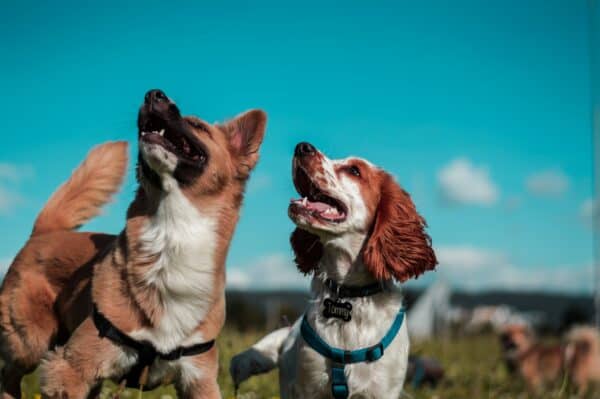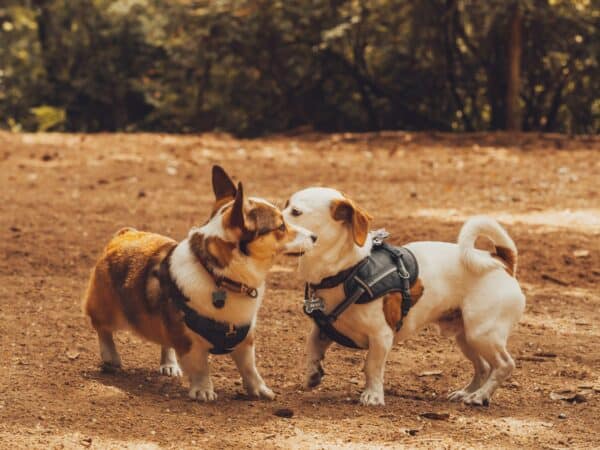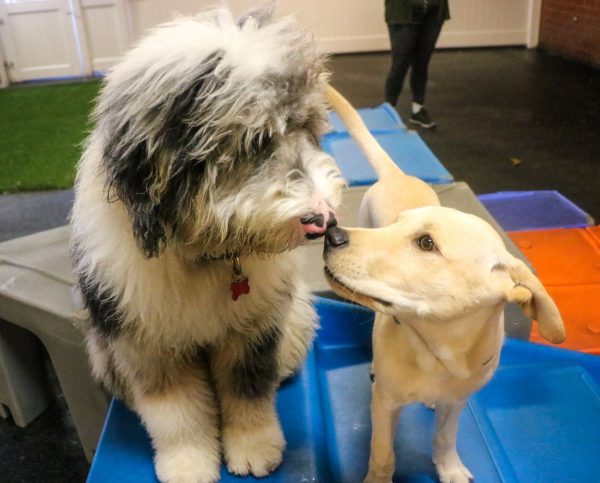Dog parks are a ubiquitous part of urban and suburban life. They serve as important social spaces for dogs and owners alike. Until now, they’ve been fairly uncontested as an accepted part of pet culture, so much so that they are found in parks and neighborhoods worldwide. But lately dog experts are begging the question: are dog parks harmful or helpful?
The answer is not so simple. There are many dog parks whose models pose major risks to dogs. But, there are undoubtedly great benefits to socializing dogs in an open-play setting, and ways to make a healthier dog park environment. Below, we explore the pros and cons of dog parks.

Are Dog Parks Harmful or Helpful?
Seemingly, dog parks benefit dogs in many ways. They provide an enclosed space for socialization and exercise. They are one of the few places where dogs can interact with an off-leash pack of their own species. Owners can delight in watching their dog play and make friends, and it gives dog owners an opportunity to connect with other pet parents as well.
But realistically, dog parks pose several risks. Some of these risks include:
INJURY
Injuries may happen. Often, these can be accidental, especially when dogs of all sizes are playing with each other in the same area. Injuries can be costly for owners and traumatizing to dogs.
While injuries can never be totally prevented, dogs are safer playing with mates that are their own size. Parks that have separate areas for large and small dogs are safer than those that comingle dogs of all sizes.
SPREAD OF DISEASE
Usually, dogs do not need to have any kind of health check to go to a dog park. So while your dog is slobbering, sniffing, and sharing water with the rest of the pack, they may pick up some unfavorable sicknesses.
Dog parks that have fountains, rather than bowls, give dogs continuously renewed water rather than shared still water. Though they may be licking from the same faucet, no two dogs are drinking the same water. This is a safer alternative for a public space.
SOCIALLY OVERWHELMING
The open-play environment of a dog park, without the mediation of attentive dog owners or handlers, can be overwhelming for dogs. Often, dogs will rush around the entrance gate when they see a new mate entering the space. And for a while after a new dog enters the space, the rest of the pack will be intrigued to learn about them. You may see your dog being tailed by a small group of butt-sniffing dogs, or invited to play by a bowing, bouncy friend. The point is: your dog is going to be hounded – at least a little bit – when they enter the park.
It’s important to socialize your dog before going to a dog park. If a dog’s first time around other dogs is in a dog park context, they can easily be overwhelmed. Then again, some dogs will take to the attention well and mesh right with the group. It really comes down to the personality of your dog.
If you’re trying to ease into dog park life, try going at a time when there’s less traffic. Your dog can get used to the environment without the stimulation of a big crowd.
LEARNING BAD BEHAVIORS
Dogs learn by watching what their mates do. Oftentimes, dogs can pick up new behaviors by watching their peers at the dog park. This can include undesirable behaviors too.
Since there is no behavior test required for most dog parks, dogs being socialized at the park have a heightened chance of adopting naughty behavior exhibited by other dogs. The best chance at curbing bad behavior is by correcting your dog as soon as you see them do it.
RESOURCE GUARDING
Resource guarding is when a dog displays aggressive, threatening behavior in order to protect their access to valuable things such as food, toys, or people. Dogs may display resource guarding at the dog park, especially when there are toys around. Dogs can also resource guard humans, which we talk more about below. Resource guarding may start as growling and escalate to a full-on fight.
OWNER PERCEPTION
Dogs’ perception of their owner can be altered in the dog park. Owners may also unwittingly enable bad behaviors. Here are a few examples:
The Uninformed Owner: Some owners do not know how to distinguish between styles of play. This can go either way: a helicopter parent who stops all rough play, or someone who lets reckless behavior play out for too long. It’s good to educate yourself on dog play styles before taking your dog to the park, so you know when to intervene.
Facilitated Aggression: Rather than joining the group play, some dogs will hang by their owners’ side at the dog park, and growl at any dogs who come up. This is a form of resource guarding. If your dog would rather hang out with you than with other dogs at the park, it’s probably a good sign that they’re not very interested in the environment. You might be better off seeking an alternative enrichment activity for your dog.
Owner Helplessness: Another phenomenon that can happen at the park is something called owner helplessness. Basically, if owners do not know when to intervene in roughhousing, dogs realize that they are on their own to fend for themselves. Although their humans, who care for and protect them, are nearby, if they are not paying attention while a dog is being harassed or bullied by their playmates, then the perception of their owner and relationship can be affected. There is a fine line between letting your dog learn to stand up for themselves and knowing when to step in to protect them.
AGE
Some experts say that dog parks are not safe places to socialize dogs between the ages of 6 – 12 months, because of risks to physical and behavioral health. At the other end of the spectrum, older dogs often do not have the energy or patience for playing at dog parks. There is a sweet spot in the middle where dogs should be socialized, confident, and energetic enough to handle playtime.
SUSTAINED AROUSAL
Arousal is a state of alertness or readiness for action. Dogs who are easily aroused might display rambunctious behavior when presented with cues that either positively or negatively affect them. Group play at a dog park can cause dogs to display sustained arousal, making it hard for them to calm down. In other words, dogs get too hyped up and can’t tell when the party is over. An aroused dog may continue to send playful cues to the other dogs long after they are tired of playing. This can result in a tired dog snapping at an aroused dog to signal that they do not want to play. If the aroused dog is too excited to pick up on the social cues of their playmates, they can be ganged up on by the other dogs who have grown tired of their antics.
In addition to social health, a dog’s physical health can be compromised by sustained arousal as well. Specifically, brachycephalic, aka short-nose dogs, have a harder time breathing because of their short and tight breathing passages. If they exercise too intensely for too long, they have a heightened risk of heat stroke, breathing problems, and more.
Whenever possible, it’s a good idea to exercise your dog before going to the dog park so they can exert some extra energy. Dogs need regular exercise in order to feel their best. Although the dog park can be great for exercise, if a dog has too much energy going into the park, they could display some sustained arousal.
HEIGHTENED CHANCE FOR TRAUMATIC INCIDENTS
However prepared the dog or owner is, there are many emergent properties that arise when dogs are in a dog park environment. Owners would do well to understand that there is always an inherent risk of injury at the dog park. Dog language changes when they are in an open-play setting, and owners may see new behaviors exhibited. These are all risks you take at the dog park.

THE FITDOG DIFFERENCE
There are ways to mitigate the potential of these risks. At Fitdog, we developed an open-play environment that mirrors the best parts of a dog park while minimizing the risks associated with most dog parks.
Separation of Space
Our play yard is separated into two areas, one for large dogs and one for small dogs. This minimizes the risk of injury because it ensures dogs are playing with mates their own size.
Behavioral Test Required
All dogs are required to pass a socialization test before entering the yard. If dogs show they are comfortable enough with other dogs, they are allowed on the yard for a two-hour observational period. At that time, our staff determines whether an open-play environment is suitable for the dog. If there is an instance where two particular dogs do not get along, they are rotated between play time on the yard and rest time in a private suite so they do not interact with each other.
Vaccines Required
We require that all dogs be current on their rabies, bordetella, DHPP (distemper/parvo), lepto, and canine flu vaccines. Additionally, our staff keeps a close eye on dogs to look for symptoms of illness.
Water Cycling
Dogs share water buckets on the play yard, but the buckets are changed out several times a day to promote good health practices.
No Toys or Food Allowed
The absence of toys and food mitigates the chances for resource guarding. Dogs play on play structures, with each other, and with the dog attendants supervising them on the yard.
Attentive Dog Handlers
All dogs on the yard are supervised by at least one dog handler. All of our dog handlers are trained to understand dog behaviors before attending the play yard. They also learn the personalities of our dogs so they can take a proactive approach to behavioral management.
Owner-Free Environment
Another way that we minimize incidents is by maintaining an owner-free environment. The role of a dog changes when they feel they have to guard or protect their owner. The absence of owners allows dogs to focus on forming relationships with their pack members.

10 Dog Park Do’s and Don’ts
So maybe your dog loves the dog park. We get it. If you still want to take your dog to the park, here are our top ten dog park do’s and don’ts:
1. Do be attentive.
We recommend keeping your eyes on your dog at all times while they are playing. It’s tempting to snap a thousand pictures of your pup being cute at the park, but cell phones can be a real distraction in an open play environment.
Additionally, you want to remain attentive to make sure your dog is behaving well, and that other dogs are playing nicely around the park. Things happen, but being vigilant can prevent altercations, escapes, and poop-eating.
2. Don’t be surprised when other dogs want to play with your toys.
Toys are great for one-on-one playtime with your pup. But when toys are brought into a dog park, chances are other dogs will be interested in playing with them, too. Toys heighten the risk of resource guarding, which can lead to fights. We recommend that you let dogs play with each other and save the toys for your one-on-one playtime.
3. Do bring your own water.
Some parks have water bowls out, but from our experience, they are usually pretty nasty. Also, sharing water can increase your dog’s chance of contracting a disease. Bring a collapsible water bowl to ensure your dog is well-hydrated and healthy.
4. Don’t judge a dog’s sociability by their breed.
All dogs have unique personalities. The best gauge for whether or not a dog is friendly and sociable is all in their demeanor. The breed does not make the dog, the owner’s training makes the dog. Ask yourself: does this dog look calm? Friendly? Is their tail stiff (usually meaning apprehensive and alert) or wagging (happy and curious)? You never know who your dog will become friends with!
5. Do bring tags.
Some dog parks will fine you if your dog does not have proper identification. Plus, if your dog escapes from the park, you’re more likely to find them again if they are wearing tags. Bringing a leash, collar, and tags is a foolproof way to see that your dog gets in and out of the park safely without any fines.
6. Don’t let your dog jump on others.
There are some people who will welcome a jumping dog. But many people do not welcome that behavior. Remember: not all people are dog people, and even if they are, it doesn’t warrant your dog’s intrusive behavior.
7. Do clean up after your dog.
Usually, parks rely on owners to clean up after their dogs. Everyone is responsible for cleaning up after their dog at the park, so make sure you bring poop bags and pack out all of your trash when exiting the park.
8. Don’t be afraid to make friends!
If your dog is really clicking with another furball, you can always exchange contact information with their owner to arrange for future playdates. Who knows, you could make a new friend as well!
On the contrary, if an owner seems disinterested in arranging playdates for your pets, don’t take it personally– you never know where they’re coming from.
9. Do take responsibility for your dog’s actions.
By entering the dog park as your pet’s chaperone, you are agreeing to take responsibility for your dog’s actions. In the event of an altercation, you are obligated to exchange information with the other owner. Likewise, if your dog is hurt in a park incident, you have the right to request the other owner’s information.
10. Do allow butt-sniffing.
Dogs get to know each other by smelling each other’s butts. Nose-to-nose contact can be intimidating to some dogs, but butt-sniffing is totally normal to them. If your dog goes around meeting friends in this way, just know it’s normal. Now, if your dog goes up sniffing human butts, that’s when you can step in.

Butt-sniffing is a healthy and friendly social interaction between dogs!
So, are dog parks harmful or helpful? Just as we humans have preferences for social environments, dogs do too. There are dogs who will thrive in an open-play environment such as a dog park, and those that do not. It just comes down to knowing your dog.
If your dog does not like the dog park, don’t fret! There are plenty of ways to socialize dogs, from small group classes, to pack walks, one-on-one playdates, and more. And don’t underestimate the value of a simple walk or play session between you and your dog – it means a lot to them!